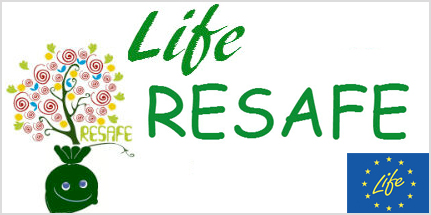Agriculture: from waste a new high-quality fertilizer reducing water consumption
4/2/2016
It’s called RESAFE and it’s an organic fertilizer allowing to reduce water consumption in crop cultivation and improve soil fertility.
 RESAFE has been developed under the European project Life+RESAFE, a 1.3 million euro project half funded by the European Union, implemented by an international consortium composed by ENEA, Sapienza University of Rome – Department of Chemical, Materials and Environmental Engineering -, Astra Innovation and Development (Faenza), ENIA Rdi Ltd (Cyprus) and the Spanish National Research Council CEBAS-CSIC.
RESAFE has been developed under the European project Life+RESAFE, a 1.3 million euro project half funded by the European Union, implemented by an international consortium composed by ENEA, Sapienza University of Rome – Department of Chemical, Materials and Environmental Engineering -, Astra Innovation and Development (Faenza), ENIA Rdi Ltd (Cyprus) and the Spanish National Research Council CEBAS-CSIC.
The most innovative feature of this green fertilizer lies in its double action on crops and on soil characteristics, preserving the soil functions of water filtration and water retention, consequently reducing water consumption and preserving or restoring soil fertility, combating soil erosion and soil sealing, two growing phenomena.
“This fertilizer is the symbol of a circular economy, in which waste can be turned into a resource for new products - Alice Dall’Ara, ENEA contact person for the project explains - the “recipe” contains compost mixed with poultry manure and bio-char, biomass residue produced from pyrolysis, with the addition of vegetable active principles, following a method patented in Europe. It’s a product that increases water retention in soil and nutrients provided to plants, reducing the salinity content of soil thanks to bio-char and restoring the structure of soil, lowering the risk of erosion”.
“In the Italian version of the fertilizer - Dall’Ara says - we reached a nitrogen content of about 3% and there was formation of struvite, a mixture of nitrogen and phosphorous that allows to reduce underground water pollution”.
The presence of struvite (one of the elements essential to the quality and commercial value of the fertilizer) was detected thanks to the characterization technologies made available by the ENEA Faenza Technology of Materials Laboratory, which also selected by-products and waste to be used as raw materials; planned the fertilizers to test before selecting the best performing one; implemented the pilot plant of Faenza together with Astra; analyzed the life cycle of the fertilizer (LCA) to assess technical feasibility of production; created a data bank available to all project partners.
Within the project Life RESAFE, a possible reduction of the environmental impact and cost reduction for farmers, breeders and urban waste managers were analyzed, on the basis of different fertilizing strategies envisaging full or partial use of the fertilizer.
Tests on vegetable crops were carried out (potato, melon, watermelon, tomato, cabbage) and on extensive crops (corn, barley, durum wheat) in two environments presenting different soil fertility.
The new fertilizer proved to be very interesting both from a quality and a production point of view: on 14 tests carried out using exclusively the fertilizer RESAFE, it scored first for productivity in 7 cases and second in 4 other tests.
For more information please contact:
Alice Dall’Ara, ENEA Faenza Research Center, alice.dallara@enea.it
